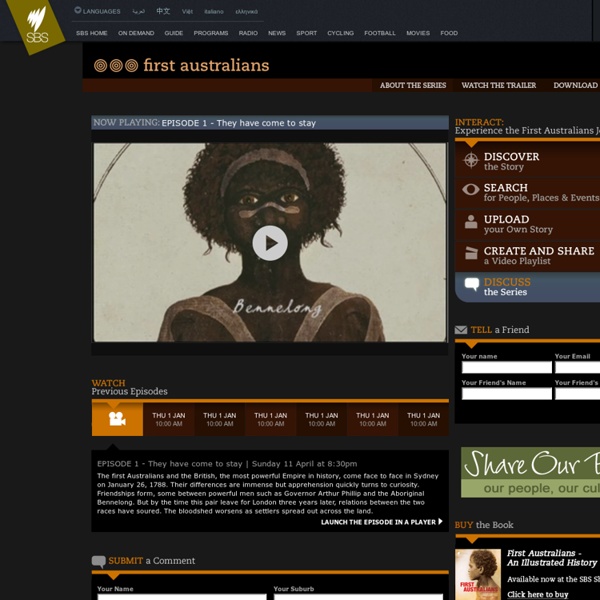



Mabo/Mabo - the film/Mabo Full Length Movie This is an NFSA Digital Learning resource. See all Digital Learning websites. Support For Teachers Credits Contact Copyright & Legal Screen Australia Digital Learning Famous Aboriginal people, activists & role models - Creative Spirits Why we need Aboriginal role models Apart from obvious reasons like inspiration, setting an example, or showing what is possible, there's a more opaque reason we need Aboriginal role models: the media. Journalists lack interest in reporting about Aboriginal achievers. Read my tips for journalists. Who's missing? David Unaipon If you live in Australia, do you know that you're probably carrying a famous Aboriginal man in your wallet? The front of Australia's 50-dollar note, first issued on 4 October 1995, features David Unaipon along with drawings from one of his inventions, and an extract from the original manuscript of his book Legendary Tales of the Australian Aborigines, for which he is known as the first Aboriginal author. Before the redesign in 2018, the 50-dollar note showed a couple standing in front of Raukkan Church. David Unaipon fact file Cathy Freeman Cathy Freeman is one of the most well-known Aboriginal Australians. Cathy Freeman fact file Neville Bonner Neville Bonner fact file
Australia Australian History Trove Pictures of Australia Take a look at the Picture Australia site. This site will not be officially lauched for a while yet. I provides a single point of access to over 450,000 digitised images from pictorial collections of many leading cultural heritage institutions. Bushrangers The Ned Kelly Gang Would you like to learn what errors there are in the information you may have read about the Kelly gang? Not Just Ned From the National Museum of australia. Australian Explorers Project Gutenberg - Australia This site is very comprehensive with many links and covers, a lot of primary source material for download. eBooks and excerpts - quite delightful. Convicts Port Arthur Convict Site. Convict Central an interesting resource where you can research your convict past. in London. Claytons Convicts Fill in this dialogue box and makeup your own convict history. First Fleet First Fleet Fellowship Lists ships and convicts who were on board each ship, includes images and stories. Gold
campsie Aboriginal history Barani Barani is an Aboriginal word of the Sydney language that means 'yesterday'. The Barani website examines the histories of people, places and events associated with Sydney's Aboriginal and Torres Strait Islander peoples. Visit Barani The first Sydneysiders Aboriginal peoples have always lived in Sydney . There are about 29 clan groups of the Sydney metropolitan area referred to collectively as the Eora Nation. Following the arrival of the First Fleet in 1788, the British encountered Aboriginal people around the coves and bays of Port Jackson. Despite the destructive impact of first contact, Gadigal culture survived. Sydney’s inner suburbs have long been a magnet for Aboriginal peoples seeking work opportunities, shelter and connections with community and family. There was a growing political activism within Sydney’s Aboriginal community over the 20th century, which led to the development of support systems and facilities for urban Aboriginal people. Barani: a living history Links
Burarra Gathering - Welcome | Aboriginal and To... funfriends.wikispaces French and English content Aboriginal History Bee Gees Dear Bev, Wow! Your WIKI is the best. General - Aboriginal Education - The Department of Education Aboriginal English & ESL Educational Resources Information Centre (ERIC)Free database of resources that may assist teachers with teaching ESL/D students. Details Aboriginal Parent Easy Guides Parent Easy Guides (or PEGs as they are affectionately known) bring simple, easy-to-read information on many of the issues faced by parents from birth through adolescence. Details Aboriginal Studies Virtual Library Links to resources in a variety of categories are suggested. Details Aboriginal astronomy - ABC Science ABC The Indigenous people of Australia have their own knowledge of the solar system which has been accumulated over many thousands of years. Details Australian Institute of Aboriginal and Torres Strait Islander Studies Promotes Aboriginal studies through research, publications, training, and the establishment and maintenance of cultural resource collections. Details Black Pages Details Bush Food Books that discuss surviving in the bush and how you can live off the land on bush tucker and water.
chez moi Indigenous Weather Knowledge - Bureau of Meteorology Aboriginal and Torres Strait Islander people have developed an intricate understanding of the environment over many thousands of years. Artist: Laurie Nilsen The artwork used in the design of this website represents the relationships between seasonal, meteorological and astronomical changes - and how the Mandandanji people read these changes to inform life on country. About the Indigenous Weather Knowledge website Learn more about the Indigenous Weather Knowledge (IWK) website and the Bureau of Meteorology's commitment to strengthening respectful and collaborative relationships with Aboriginal and Torres Strait Islander people. About the Indigenous Weather Knowledge website Language, culture and environmental knowledge See an overview of the relationships between language, culture and environmental knowledge. Language, culture and environmental knowledge Reconciliation Action Plan Download our RAP
my class